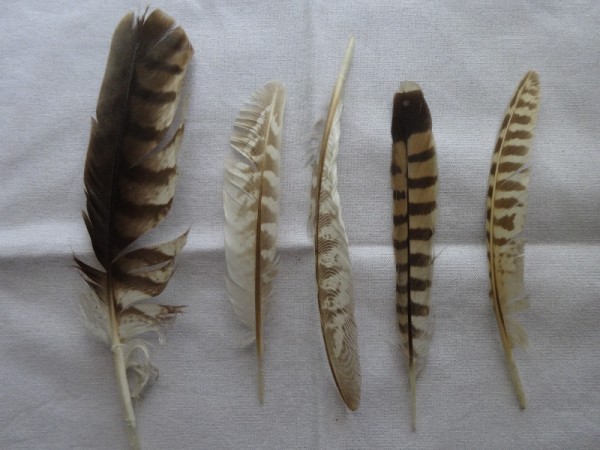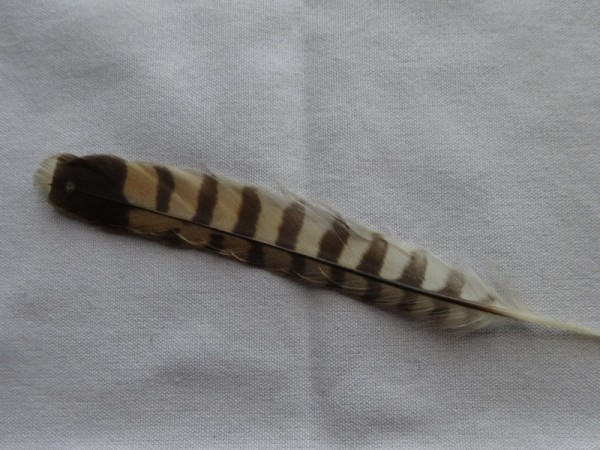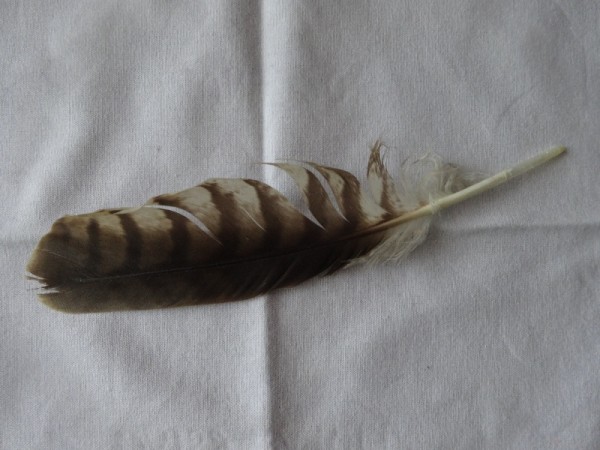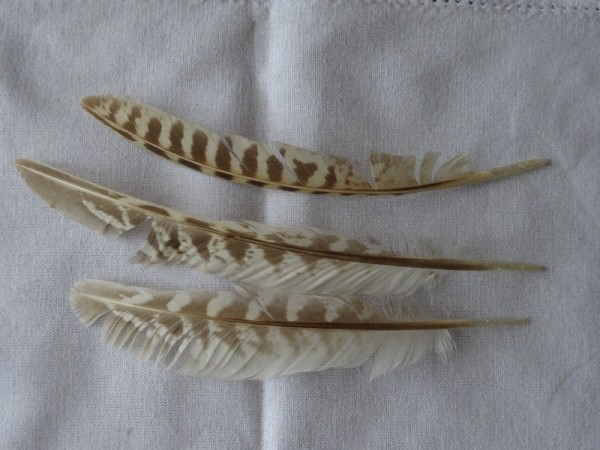
Feathers picked up from the garden: The large one is from a red kite, the smaller dark one is a kestrel’s and the 3 lighter coloured ones are pheasant”s.
We live in Red Kite country and you can quite often find their feathers in the garden. The birds are connoisseurs of thermals and when they find some good ones they spend whole afternoons on display flying, making their curious and slightly pathetic mewing call as they go. The sky can be full of these enormous birds ( 20 – 30 each with a wingspan of 5 feet or more) which are never less than an arresting sight and for a fraction of a second you suspect you might have strayed into prehistory and be back with the dinosaurs.
We’ve had a couple of near misses with them in the garden when for some as yet unfathomed reason they’ve swooped low on someone sitting in a deckchair – but they’re so swift the deckchair sitter comes away thinking they must have made it up. Occasionally you see a bird sitting in your garden or in nearby fields. Heavy-looking and large bodied they somehow manage to look rather cuddly (if you ignore the large curved beak!) and even have something cat-like about them. Their nests reveal a more frivolous side as they have a fondness for bright plastic objects like children’s toys, little toy teddy bears, crisp packets and even bits of underwear, which they string up around the edge of the nest just as we would put paintings on our walls and ceramics on our shelves. They obviously get fed up of these from time to time – or perhaps more discerning – as the ground below the nests are often littered with things they’ve rejected.
RSPB Scotland points out that Shakespeare recorded red kites’ scavenging of man-made materials when he warned ‘when the kite builds, look to lesser linen,’ in The Winter’s Tale (Act 4, scene 3).
Last night’s BBC 2 Autumn Watch had a piece on kites in Reading. More red kites are coming into the city and the programme mentioned that one of the attractions was that people were feeding them (with raw chicken meat) in their gardens. But they should have pointed out that nutritionally garden feeding is not doing them any good unless we leave out whole chickens, or better still roadkill – feathers, bones and all – so they can get all the nutrients they need for healthy living. Several years ago chicks that were monitored were discovered to suffer from malnourishment because of such feeding and for a while we were encouraged to let them find their own food. It now seems we should be reminded about this again.
To date I haven’t seen any of those deep orange-red feathers which give the birds their name.
Saturday 7 November:
What I now realise I hadn’t pointed out for people living outside Britain is that the red kite became extinct in Britain in the C19th. In 1989 red kites from Spain were introduced locally into the Chilterns and have been phenomenally successful both in terms of breeding and in terms of the pleasure they give. For a brief history of the red kite in Britain and photos see here.




8 Comments
You do have a wonderful collection of patterned feathers, though!
I do and we do enjoy watching the birds as well – they are great time consumers as once you begin staring at them you become quite mesmerised.
I had to look up what a kite looked like since we do not have any in Virginia. What we do have are red shouldered hawks who are very noisy but beautiful birds.
Sorry, I should have linked to a picture. I’ve just had to look up red shouldered hawks and they look very like the red kites in almost every aspect apart from the kites having more tapered wings. The red kites are remarkable for us because they were driven to extinction in England in the C19th and were completely absent from our skies until 1989 when red kites from Spain were released into the Chilterns. Now there may well be well over 1,000 breeding pairs in the area and some of these have themselves been sent to seed populations elsewhere in Britain. The red kite reintroduction has been an enormous success – this is why we get so excited about them. Thank you for drawing my attention to your local glamorous bird.
Only the first one is from a red kite. 3 light ones are from pheasants and the other barred one is the tail feather of a kestrel
Thanks for this, Val. It’s very helpful and useful to have these distinctions made. I’m surprised there weren’t more kite feathers in the garden during the eight years we lived in the vicarage as they were constantly with us in the skies above. I do miss them.
Interesting, and some beautiful photos, thanks! Red kites never completely died out in Britain: in 1989, when the Spanish ones were introduced there were still a couple of dozen native red kites in mid Wales. There are many more here today. I can’t imagine life without them, so I can understand how much you miss them!
Thanks for this, Mike.
We have lived in Cheltenham since 2017 (via a year in London) and as yet no red kites here – more’s the pity. We loved to see them in Ipsden where watching them was a mesmerising way for long passages of time to go by.
During our first year in Cheltenham it was gulls, gulls and gulls again – very noisy and not so mesmerising!